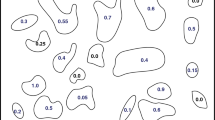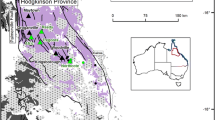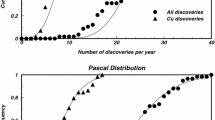Abstract
Empirical evidence indicates that processes affecting number and quantity of resources in geologic settings are very general across deposit types. Sizes of permissive tracts that geologically could contain the deposits are excellent predictors of numbers of deposits. In addition, total ore tonnage of mineral deposits of a particular type in a tract is proportional to the type’s median tonnage in a tract. Regressions using size of permissive tracts and median tonnage allow estimation of number of deposits and of total tonnage of mineralization. These powerful estimators, based on 10 different deposit types from 109 permissive worldwide control tracts, generalize across deposit types. Estimates of number of deposits and of total tonnage of mineral deposits are made by regressing permissive area, and mean (in logs) tons in deposits of the type, against number of deposits and total tonnage of deposits in the tract for the 50th percentile estimates. The regression equations (R 2 = 0.91 and 0.95) can be used for all deposit types just by inserting logarithmic values of permissive area in square kilometers, and mean tons in deposits in millions of metric tons. The regression equations provide estimates at the 50th percentile, and other equations are provided for 90% confidence limits for lower estimates and 10% confidence limits for upper estimates of number of deposits and total tonnage. Equations for these percentile estimates along with expected value estimates are presented here along with comparisons with independent expert estimates. Also provided are the equations for correcting for the known well-explored deposits in a tract. These deposit-density models require internally consistent grade and tonnage models and delineations for arriving at unbiased estimates.
Similar content being viewed by others
References
Aitchison, J., and Brown, J. A. C., 1963, The lognormal distribution: Cambridge University Press, Cambridge, 176 p.
Lisitsin, V. A., Moore, D. H., Olshina, A., and Willman, C. E., 2010, Undiscovered orogenic gold endowment in Northern Victoria, Australia: Ore Geol. Rev., v. 38, no. 3, p. 251–269.
Singer, D. A., 2008, Mineral deposit densities for estimating mineral resources: Math. Geosci., v. 40, no. 1, p. 33–46.
Singer, D. A., 2011, A lognormal distribution of metal resources: J. China Univ. Geosci., v. 36, no. 2, p. 1–8.
Singer, D. A., and Kouda, R., 2008, Probabilistic estimates of number of mineral deposits using deposit densities, in Abstract CD-ROM, 33rd International Geologic Congress, Oslo, Norway, 6–14 August 2008, 1 p.
Singer, D. A., and Menzie, W. D., 2010, Quantitative mineral resource assessments—an integrated approach: Oxford University Press, New York, 219 p.
Author information
Authors and Affiliations
Corresponding author
Rights and permissions
About this article
Cite this article
Singer, D.A., Kouda, R. Probabilistic Estimates of Number of Undiscovered Deposits and Their Total Tonnages in Permissive Tracts Using Deposit Densities. Nat Resour Res 20, 89–93 (2011). https://doi.org/10.1007/s11053-011-9137-1
Received:
Accepted:
Published:
Issue Date:
DOI: https://doi.org/10.1007/s11053-011-9137-1




